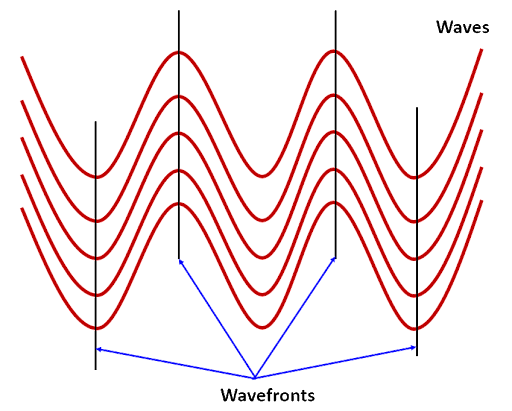
What is the definition of Wavefront?
Answer
216k+ views
Hint:A wavefront is defined as the locus of all points which are in the same phase, in other words, a wavefront is an imaginary surface, which can be visualized as the collection of all points oscillating in the same phase.
Complete step by step solution:
A wavefront is defined as a virtual surface where all the points of a particular wave are always in phase. Therefore for an oscillating wave as shown below by the red solid curves the virtual surface marked with the solid black vertical lines can be called the wavefront, because all points on the black solid lines are in phase. Depending on the nature of the wave motion a wavefront can be circular, planar, or in any symmetric geometric shape.

Image: Schematic to show the wavefronts
Some interesting properties of a wavefront can be summarized as follows:
- In the above image we have shown a stationary wavefront, but in reality a wavefront is always propagating in the direction of the motion of the wave, which can be also understood by the fact that all the particles are oscillating about their mean equilibrium position with time and space.
- The wavefront of an electromagnetic wave is always perpendicular to the direction of the propagation of the wave.
- Each wavefront gives origin to the another wavefront, which is obtained by the surface tangent (called envelope) of the collection of the wavelets and therefore helps to visualize the propagation of the wave.
Note: The wavefront always presents the collection of the points oscillating in the same phase and therefore always propagating in the same direction of the wave. The speed of the wavefront can be calculated using Huygen's principle, which states that the collection of all the wavelets give origin to the new wavefront and propagate with a speed related to the wave motion.
Complete step by step solution:
A wavefront is defined as a virtual surface where all the points of a particular wave are always in phase. Therefore for an oscillating wave as shown below by the red solid curves the virtual surface marked with the solid black vertical lines can be called the wavefront, because all points on the black solid lines are in phase. Depending on the nature of the wave motion a wavefront can be circular, planar, or in any symmetric geometric shape.

Image: Schematic to show the wavefronts
Some interesting properties of a wavefront can be summarized as follows:
- In the above image we have shown a stationary wavefront, but in reality a wavefront is always propagating in the direction of the motion of the wave, which can be also understood by the fact that all the particles are oscillating about their mean equilibrium position with time and space.
- The wavefront of an electromagnetic wave is always perpendicular to the direction of the propagation of the wave.
- Each wavefront gives origin to the another wavefront, which is obtained by the surface tangent (called envelope) of the collection of the wavelets and therefore helps to visualize the propagation of the wave.
Note: The wavefront always presents the collection of the points oscillating in the same phase and therefore always propagating in the same direction of the wave. The speed of the wavefront can be calculated using Huygen's principle, which states that the collection of all the wavelets give origin to the new wavefront and propagate with a speed related to the wave motion.
Recently Updated Pages
JEE Atomic Structure and Chemical Bonding important Concepts and Tips

JEE Amino Acids and Peptides Important Concepts and Tips for Exam Preparation

Electricity and Magnetism Explained: Key Concepts & Applications

Chemical Properties of Hydrogen - Important Concepts for JEE Exam Preparation

JEE Energetics Important Concepts and Tips for Exam Preparation

JEE Isolation, Preparation and Properties of Non-metals Important Concepts and Tips for Exam Preparation

Trending doubts
JEE Main 2026: Application Form Open, Exam Dates, Syllabus, Eligibility & Question Papers

Derivation of Equation of Trajectory Explained for Students

Hybridisation in Chemistry – Concept, Types & Applications

Understanding the Angle of Deviation in a Prism

Understanding Collisions: Types and Examples for Students

How to Convert a Galvanometer into an Ammeter or Voltmeter

Other Pages
JEE Advanced Marks vs Ranks 2025: Understanding Category-wise Qualifying Marks and Previous Year Cut-offs

Units And Measurements Class 11 Physics Chapter 1 CBSE Notes - 2025-26

NCERT Solutions For Class 11 Physics Chapter 8 Mechanical Properties Of Solids

Motion in a Straight Line Class 11 Physics Chapter 2 CBSE Notes - 2025-26

NCERT Solutions for Class 11 Physics Chapter 7 Gravitation 2025-26

Ideal and Non-Ideal Solutions Explained for Class 12 Chemistry




